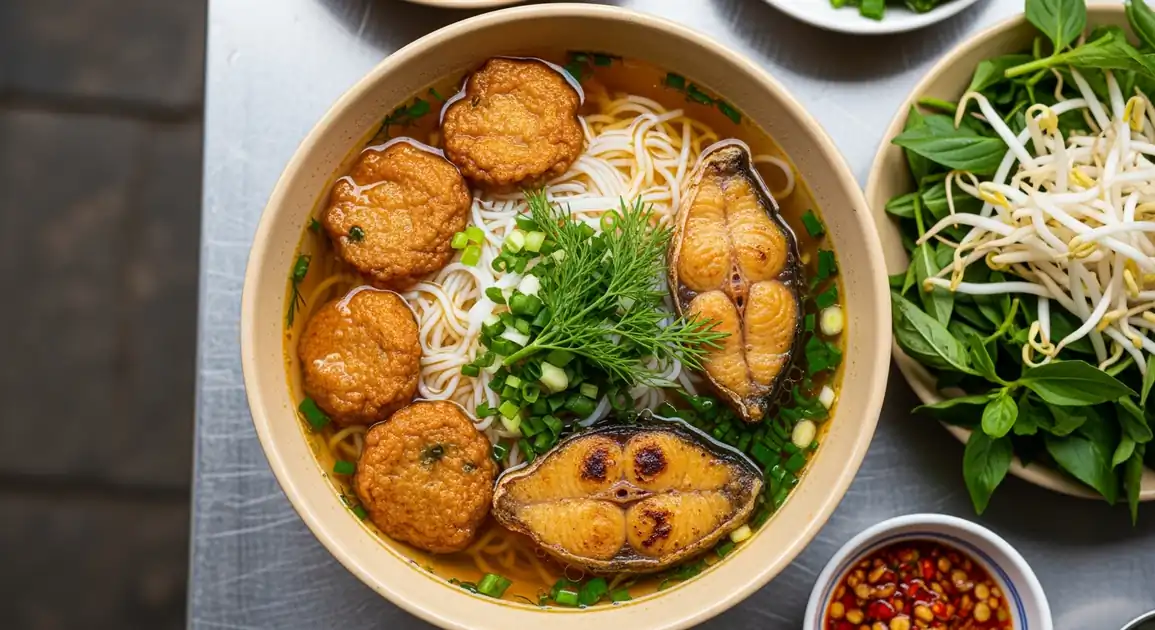Bun Ca (Fish Noodle Soup)
Bún Cá

Description
Bun Ca is primarily a Northern Vietnamese dish, with regional variations throughout the country. The most famous versions come from Hanoi and Hai Phong, each with distinct characteristics. While less internationally recognized than pho or bun cha, it's a beloved everyday dish for locals, particularly enjoyed for breakfast or lunch.
Dietary Information
Serving information
Serving style
Served in medium-sized ceramic or plastic bowls with a separate plate of fresh herbs, lime wedges, and chilies. Accompanied by small dishes for fish sauce and chili sauce for customization. Often served with Vietnamese pickled vegetables (dưa góp) on the side.
Quick facts
Most authentic vendors operate 6 AM - 1 PM. Some restaurants serve throughout the day but are typically best in mornings.
Safety Tips
What to Look For
-
Clear, amber-colored broth that's actively boiling
The broth should be visibly clear (not murky or cloudy), with a golden-amber hue from fish bones and tomatoes. Active boiling ensures proper cooking temperature is maintained.
-
Fresh, firm fish pieces with no strong fishy odor
Quality fish should have firm texture and a mild, fresh smell. Strong fishy odors indicate old fish that may cause digestive issues or contain harmful bacteria.
-
Clean preparation area with separate handling of raw and cooked fish
Cross-contamination between raw and cooked fish is a major risk factor. Good vendors keep these processes separate with different utensils and preparation areas.
-
Fresh herbs stored properly (not wilted or pre-soaked)
Herbs should look vibrant and be stored in cool conditions, not wilted or sitting in water for extended periods. They're added fresh to each bowl, not pre-mixed into the broth.
What to avoid
-
Cloudy, excessively oily, or stagnant broth
Murky broth can indicate poor preparation, old ingredients, or inadequate cooking. The broth should be relatively clear and actively simmering, not sitting at low temperature.
-
Strong fishy smell from either the broth or fish pieces
An overpowering fishy odor (rather than a fresh, marine scent) suggests old fish that may cause digestive issues or contain harmful bacteria.
-
Fish cakes with grayish color or slimy texture
Quality fish cakes should be light-colored with a springy, firm texture. Gray coloration or sliminess indicates old products or poor refrigeration.
-
Vendors who prepare large batches of noodles in advance
Pre-soaked noodles sitting at ambient temperature can develop bacteria. Good vendors prepare noodles to order or keep pre-prepared noodles properly refrigerated.
Price information
Price range
Budget tips
- Street vendors typically offer the most affordable bowls (25,000-35,000 VND).
- Prices increase in tourist areas or established restaurants (45,000-65,000 VND).
- A larger portion ('đặc biệt' or special) costs about 10,000-15,000 VND more than regular size.
- Small local places in residential neighborhoods offer better value than those on main tourist streets.
Value indicators
- Generous portions of fish and fish cake (at least 3-4 pieces).
- Abundant fresh herbs provided separately.
- Clear, flavorful broth (not watery or overly salty).
- Free refills of broth (common at authentic local places).
- Complimentary side of pickled vegetables or garlic vinegar.
Where to Find This Dish
Old Market Areas
Traditional markets typically have several Bun Ca vendors, especially in their cooked food sections.
Local wet markets, Morning markets, Food streets
Morning (6 AM - 9 AM)
University Areas
Affordable student-oriented vendors offering simplified but tasty versions.
University gates, Student housing districts
Morning (7 AM - 10 AM), Lunch (11 AM - 1 PM)
Vendor Tips
- The best vendors typically operate only in mornings when fish is freshest.
- Look for places advertising specific styles (e.g., 'Bun Ca Hai Phong') as they often specialize in authentic regional recipes.
- Vendors with visible fish preparation (not hidden in back kitchens) typically have fresher products.
How to Order
Regional Variations
-
Bun Ca Hai Phong
(Bún Cá Hải Phòng)
The Hai Phong coastal version features a lighter broth without tomatoes, more varieties of fish and seafood, and often includes fried fish pieces rather than grilled. It typically uses round rice noodles instead of flat ones and emphasizes the natural sweetness of fresh fish.
-
Bun Ca Hanoi
(Bún Cá Hà Nội)
The Hanoi version often has a tomato-based broth that's slightly sour, typically uses river fish rather than sea fish, and features more dill and green onions. It commonly includes both fish cake and fried fish pieces, served with flat rice noodles.
-
Bun Ca Hue
(Bún Cá Huế)
From central Vietnam, this version uses thicker cuts of fish, includes more lemongrass and chili, and has a spicier, more robust broth. Often served with shrimp paste on the side for added flavor.
-
Bun Ca Ri
(Bún Cà Ri)
A fusion variation featuring fish in a curry-flavored broth, showing influence from neighboring culinary traditions. More common in southern Vietnam and contains coconut milk for richness.
Cultural context
History
Bun Ca originated in Northern Vietnam, with particularly famous versions from Hai Phong coastal city and Hanoi. Its roots trace back to fishing communities utilizing fresh catches in simple, nourishing soups. While less internationally recognized than pho or bun cha, it represents the Vietnamese culinary philosophy of balancing flavors and textures while highlighting fresh, local ingredients. In Hanoi, it adapted to use river fish rather than sea fish, developing its own distinct version that often includes tomato in the broth.
Local significance
Represents Vietnam's coastal and riverine culinary traditions, highlighting the importance of fish in Northern Vietnamese diet. Considered a lighter, everyday alternative to more complex noodle soups.
Eating customs
- Customized to taste with added lime, chili, and fish sauce at the table.
- Herbs are typically added gradually throughout the meal to maintain freshness.
- Acceptable to lift the bowl to drink the last of the broth directly.
- Often eaten alongside a glass of green tea to cleanse the palate.